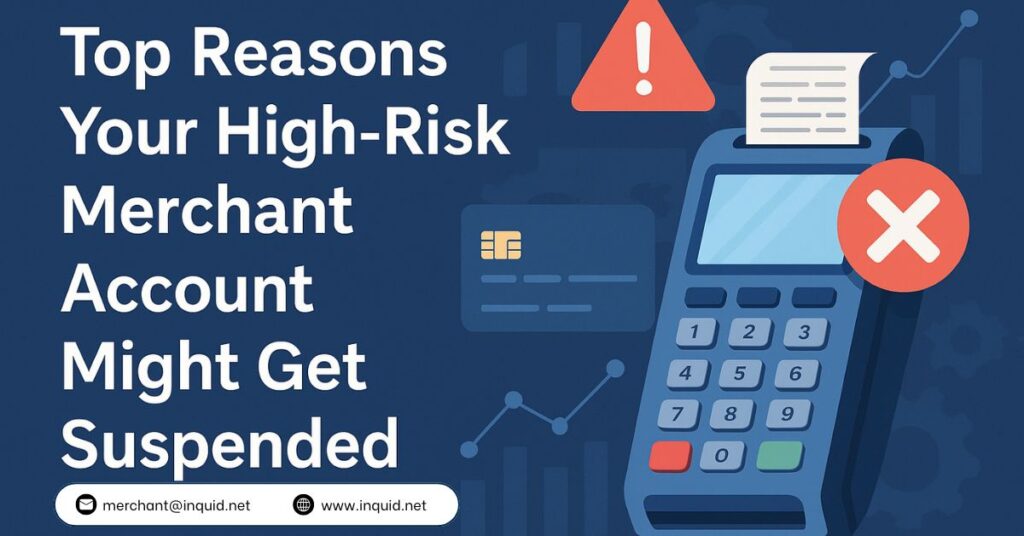
Getting a high-risk merchant account approved takes work. But keeping it active? That’s a different challenge altogether. Many businesses breathe a sigh of relief once they’ve been onboarded—only to face a high-risk merchant account suspension weeks or months later.
A suspension can disrupt cash flow, stall operations, and damage customer trust. Understanding why these accounts get suspended can help merchants avoid costly mistakes and maintain long-term processing stability.
1. High Chargeback Ratios
Chargebacks are a leading cause of suspension. While every merchant gets the occasional dispute, excessive chargebacks can raise red flags. Payment providers closely monitor the chargeback-to-transaction ratio, especially for businesses in high-risk verticals like gaming, adult, or forex.
Visa and Mastercard typically flag anything above a 1% ratio. If this trend continues over several months, a high-risk merchant account suspension becomes likely. To reduce disputes, it’s important to clarify terms, provide accurate descriptions, and use recognizable billing descriptors.
2. Incomplete or Misleading Business Information
During onboarding, merchants submit documents related to their operations, including business licenses, refund policies, product details, and KYC documents. If any of this information turns out to be false, outdated, or incomplete, the account may be shut down without warning.
Some businesses unintentionally skip updates after changing their product lineup or website structure. But providers expect real-time accuracy. It’s crucial to keep your merchant profile current at all times.
To understand what information matters most, check this list of high-risk merchant account approval steps.
3. Suspicious Processing Patterns
Unusual transaction volumes, sudden sales spikes, or irregular payment locations can trigger risk alerts. For example, if your business normally processes $20,000 a month and suddenly processes $100,000 within a few days, it could look like fraud—even if it’s legitimate growth.
Consistency is key. If you expect a spike due to a promotion or seasonal demand, it helps to notify your payment provider in advance. That level of communication can sometimes prevent a review from turning into a freeze.
4. Violations of Card Brand Rules or Industry Guidelines
Each industry has rules, especially those considered high-risk. For instance, adult, supplements, and gambling businesses often operate under stricter guidelines. Violations like selling restricted products, failing to display terms, or offering unclear refund policies can lead to a high-risk merchant account suspension.
Visa and Mastercard regularly audit acquirers, which then audit merchants. Failing to meet these requirements can cost you your account even if you’ve been processing without issue for months.
If you’re not sure which vertical-specific rules apply to your business, this guide on top high-risk merchant accounts in Europe may offer clarity.
5. Multiple MID Abuse or Transaction Laundering
Some merchants try to game the system by opening multiple accounts under different names to avoid chargeback thresholds or processing limits. This is called MID abuse, and it’s a serious violation. Another version of this is “transaction laundering,” where you process payments for a third-party business under your own account.
Both practices are considered high risk and will almost certainly result in account closure, fines, and potential legal action.
If you’re not sure how your account structure could affect your long-term stability, this post on common application mistakes is worth reviewing.
6. Delayed or Failed Document Submissions
Even after account approval, you may be asked to submit follow-up documentation. This could include updated bank statements, proof of fulfillment, or ID verification. Ignoring or delaying these requests may result in an account hold or full suspension.
Your provider is required to maintain compliance records, especially for high-risk categories. Staying responsive helps avoid disruptions.
7. Policy Non-Compliance or Reputation Issues
A merchant’s public reputation can impact their standing with a provider. Negative media, excessive complaints on forums, or violations of ad policies (especially with platforms like Meta or Google) can create reputational risk that providers may want to distance themselves from.
Additionally, if your business model shifts—say, from consulting to dropshipping—without notice, the mismatch between your merchant profile and actual activity could lead to termination.
Final Thoughts
A high-risk merchant account is a valuable asset, but it’s not a one-time win—it’s an ongoing relationship with your payment provider. Being proactive, responsive, and transparent in your operations can go a long way toward maintaining that relationship.
Want to avoid the common pitfalls that lead to suspensions? Learn more about your options with inquid’s high-risk merchant accounts.
FAQ
How do I lower my chargeback ratio?
Use clear product descriptions, issue refunds promptly, and set customer expectations honestly. A dispute alert service can also help flag potential chargebacks early.
Can I reapply if my account gets suspended?
Yes, but your previous account history will be reviewed. If you’ve made changes to address the suspension reasons, some providers will consider a second application.
How long does it take to resolve an account suspension?
It depends on the reason. Minor issues like document delays may take a few days. Serious violations or chargeback excesses may lead to permanent closure.
